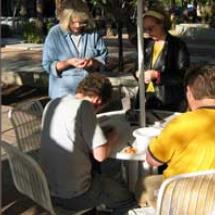Toby Schreiber visited Tucson for the third year in a row, from April 4-6, 2004. On April 6th, 2004 Toby Schreiber visited the UA campus for her third annual visit (since 2002), and delivered an illustrated lecture on the production and flaws of the ancient Greek vases. The lecture was open to the public. Representatives from the School of Art (Aurore Chabot), from the Material Sciences Engineering (Prof. Pamela Vandiver), from the Arizona State Museum, and a large number of UA students and PIMA community college attended the lecture and the workshop that followed.
A team from the Arizona State Museum (including Mike Jacobs, Teresa Serrano, and Julie Unruh) transported and exhibited in the auditorium the finest holdings of Greek pottery in the Arizona State Museum (including skyphoi, lekythoi, and lamps). The audience was indeed intrigued by their direct contact with ancient ceramic vessels. The lecture was videotaped and will be used in the future for educational purposes.
The workshop stations organized by Toby Schreiber included the following themes:
- Crushing raw Greek clay-filled soil from Kalogreza, with a hammer.
- Plasticity comparison: River bed clay, commercial, Greek clay, porcelain.
- Toughness comparison: same clays as above, only dry clay.
- Joining two sections with slip (maybe also with gloss). Examples: knob to lid, foot to body. Students make examples.
- Making and decorate a curved surface: using Greek gloss.
- Mold-made: press clay into two halves of mold (Roman head), press together, remove head.
- Making a fine horsehair brush: following Piccolpasso's directions.
- Decorating a clay tile (clay EM 343) from designs from extant Greek vases.
Email Eleni Hasaki (hasakie@email.arizona.edu) for more information







